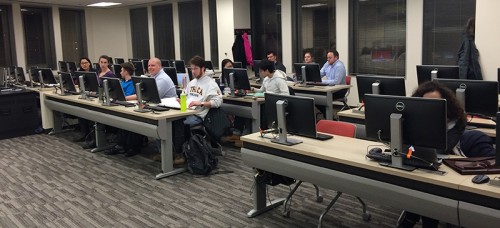
DePaul is a staple to Lincoln Park and the State Street and Jackson Boulevard in the Loop, but just beyond one of Chicago’s airports is the sprawling office complex that is home to hundreds of DePaul students — the students of DePaul’s O’Hare campus.
“The O’Hare campus is really functioning as the third Chicago campus for DePaul University,” Corinne Benedetto, an associate dean for DePaul’s School for New Learning, said.
“(The O’Hare campus) connects DePaul University with the wider metropolitan area in a way that the Loop and Lincoln Park can’t quite do,” Benedetto said.
The campus moved to its current location in 2010 after the building it occupied since 1977 was demolished to make way for the Rivers Casino in Des Plaines. The move expanded the campus, and improved visibility of the university’s brand, Benedetto said.
The proximity to the expressway makes studying at the O’Hare campus an obvious choice for most adult students who might live and work farther from the city and don’t want to fight traffic to get to a night class after work. Non traditional-aged students make up a large part of the the School for New Learning and Kelldstadt Graduate School of Business, which operate at the O’Hare campus.
“I live out in the western suburbs, so it’s a lot shorter commute (to the O’Hare campus) than going to the Lincoln Park or Loop campus,” Angela Powers, a graduate student in applied statistics said.
“It’s right around the corner, I literally walk to work.”
Much like some students split their course loads between the Lincoln Park and Loop campuses, Mike Hannan, moves from Lincoln Park to the O’Hare campus on a weekly basis.
“I go to Lincoln Park on Mondays, and on Tuesdays I go to O’Hare. It’s just the way my courses lined up,” Hannan said. “I live in Arlington Heights. It takes me about an hour and 15 minutes to get to Lincoln Park, and (to O’Hare) is about 40 minutes.”
Since the bulk of DePaul’s students commute from somwhere in the city, Benedetto encourages students that live along the Blue Line or on the Northwest Side to take some classes at the O’Hare campus. “I think that anybody perusing the offerings here would see a great range of subject matters, most of which have already been approved for liberal studies credit,” says Benedetto.
In addition to the O’Hare campus, a smaller number of classes are also held in Naperville. DePaul also operated campuses in Rolling Meadows, Lake Forest and Oak Forest, but those have closed in recent years citing a lack of enrollment.
Though DePaul’s Facilities Operations Office and Office of Public Relations declined to provide an exact number of students enrolled at the O’Hare campus, the Office of Institutional Research and Market Analytics’ website says it is home to about one in 200 of DePaul’s students. The campus is expected to grow in the coming
years largely due to associations DePaul has set up with the businesses lining the Kennedy Expressway by O’Hare airport. The headquarters of Wilson Sporting Goods shares a complex with DePaul, as does hardware chain True Value.
“People who work there are often surprised and pleased to find the University right on site,” says Benedetto.
Since the O’Hare campus is still within the city limits of Chicago, Benedetto sees the it campus as a bridge between the rest of the University and suburbs.
“It’s brought the general (DePaul) brand into greater visibility out in that area where we precisely need to make good, strong ties been our Chicago metropolitan and suburban students, and the DePaul community,” Benedetto said.

